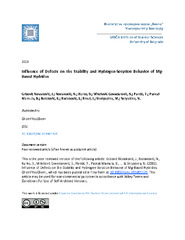| dc.creator | Grbović-Novaković, Jasmina | |
| dc.creator | Novaković, Nikola | |
| dc.creator | Kurko, Sandra V. | |
| dc.creator | Milošević Govedarović, Sanja S. | |
| dc.creator | Pantić, Tijana | |
| dc.creator | Paskaš Mamula, Bojana | |
| dc.creator | Batalović, Katarina | |
| dc.creator | Radaković, Jana | |
| dc.creator | Rmuš, Jelena | |
| dc.creator | Shelyapina, Marina | |
| dc.creator | Skryabina, Nataliya | |
| dc.creator | de Rango, Patricia | |
| dc.creator | Fruchart, Daniel | |
| dc.date.accessioned | 2019-07-10T12:30:41Z | |
| dc.date.available | 2020-05-20 | |
| dc.date.issued | 2019 | |
| dc.identifier.issn | 1439-4235 | |
| dc.identifier.uri | https://vinar.vin.bg.ac.rs/handle/123456789/8169 | |
| dc.description.abstract | This review deals with the destabilization methods for improvement of storage properties of metal hydrides. Both theoretical and experimental approaches were used to point out the influence of various types of defects on structure and stability of hydrides. As a case study, Mg, and Ni based hydrides has been investigated. Theoretical studies, mainly carried out within various implementations of DFT, are a powerful tool to study mostly MgH 2 based materials. By providing an insight on metal-hydrogen bonding that governs both thermodynamics and hydrogen kinetics, they allow us to describe phenomena to which experimental methods have a limited access or do not have it at all: to follow the hydrogen sorption reaction on a specific metal surface and hydrogen induced phase transformations, to describe structure of phase boundaries or to explain the impact of defects or various additives on MgH 2 stability and hydrogen sorption kinetics. In several cases theoretical calculations reveal themselves as being able to predict new properties of materials, including the ways to modify Mg or MgH 2 that would lead to better characteristics in terms of hydrogen storage. The influence of ion irradiation and mechanical milling with and without additives has been discussed. Ion irradiation is the way to introduce a well-defined concentration of defects (Frankel pairs) at the surface and sub-surface layers of a material. Defects at the surface play the main role in sorption reaction since they enhance the dissociation of hydrogen. On the other hand, ball-milling introduce defects through the entire sample volume, refine the structure and thus decrease the path for hydrogen diffusion. Two Severe Plastic Deformation techniques were used to better understand the hydrogenation/dehydrogenation kinetics of Mg- and Mg 2 Ni-based alloys: Equal-Angular-Channel-Pressing and Fast-Forging. Successive ECAP passes leads to refinement of the microstructure of AZ31 ingots and to instalment therein of high densities of defects. Depending on mode, number and temperature of ECAP passes, the H-sorption kinetics have been improved satisfactorily without any additive for mass H-storage applications considering the relative speed of the shaping procedure. A qualitative understanding of the kinetic advanced principles has been built. Fast-Forging was used for a “quasi-instantaneous” synthesis of Mg/Mg 2 Ni-based composites. Hydrogenation of the as-received almost bi-phased materials remains rather slow as generally observed elsewhere, whatever are multiple and different techniques used to deliver the composite alloys. However, our preliminary results suggest that a synergic hydrogenation / dehydrogenation process should assist hydrogen transfers from Mg/Mg 2 Ni on one side to MgH 2 /Mg 2 NiH 4 on the other side via the rather stable a-Mg 2 NiH 0.3 , acting as in-situ catalyser. © 2019 Wiley-VCH Verlag GmbH & Co. KGaA, Weinheim | en |
| dc.language.iso | en | |
| dc.relation | info:eu-repo/grantAgreement/MESTD/Integrated and Interdisciplinary Research (IIR or III)/45012/RS// | |
| dc.relation | info:eu-repo/grantAgreement/MESTD/Integrated and Interdisciplinary Research (IIR or III)/45018/RS// | |
| dc.relation | info:eu-repo/grantAgreement/MESTD/Basic Research (BR or ON)/171001/RS// | |
| dc.relation.isversionof | https://vinar.vin.bg.ac.rs/handle/123456789/8161 | |
| dc.rights | embargoedAccess | |
| dc.rights.uri | https://creativecommons.org/licenses/by-nc/4.0/ | |
| dc.source | ChemPhysChem | |
| dc.subject | ab initio calculations | en |
| dc.subject | energy conversion | en |
| dc.subject | hydrides | en |
| dc.subject | hydrogen energy | en |
| dc.subject | materials science | en |
| dc.title | Influence of Defects on the Stability and Hydrogen‐Sorption Behavior of Mg‐Based Hydrides | en |
| dc.type | article | en |
| dc.rights.license | BY-NC | |
| dcterms.abstract | Фруцхарт, Даниел; Милошевић Говедаровић, Сања С.; Грбовић-Новаковић, Јасмина; Новаковић, Никола; Курко, Сандра В.; Пантић, Тијана; Паскаш Мамула, Бојана; Баталовић, Катарина; Радаковић, Јана; Рмуш, Јелена; Схелyапина, Марина; Скрyабина, Наталиyа; де Ранго, Патрициа; | |
| dc.date.updated | 2020-11-30T10:10:52Z | |
| dc.rights.holder | © 2019 Wiley-VCH Verlag GmbH & Co. KGaA, Weinheim | |
| dc.citation.volume | 20 | |
| dc.citation.issue | 10 | |
| dc.citation.spage | 1216 | |
| dc.citation.epage | 1247 | |
| dc.identifier.wos | 000472446600004 | |
| dc.identifier.doi | 10.1002/cphc.201801125 | |
| dc.citation.rank | M21 | |
| dc.identifier.pmid | 30913344 | |
| dc.description.other | This is the peer reviewed version of the following article: Grbović Novaković, J., Novaković, N., Kurko, S., Milošević Govedarović, S., Pantić, T., Paskaš Mamula, B., ... & Skryabina, N. (2019). Influence of Defects on the Stability and Hydrogen‐Sorption Behavior of Mg‐Based Hydrides. ChemPhysChem., which has been published in final form at [http://dx.doi.org/10.1002/cphc.201801125]. This article may be used for non-commercial purposes in accordance with Wiley Terms and Conditions for Use of Self-Archived Versions. | |
| dc.type.version | acceptedVersion | |
| dc.identifier.scopus | 2-s2.0-85064706526 | |
| dc.identifier.fulltext | https://vinar.vin.bg.ac.rs/bitstream/id/11389/AccMan_10.1002_cphc.201801125.pdf | |

